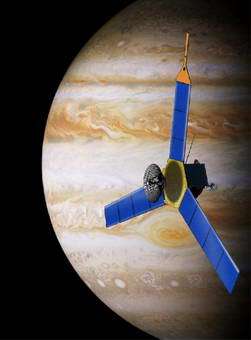SwRI to provide two science instruments for NASA's Juno mission

NASA has selected a Southwest Research Institute (SwRI) scientist to lead the next mission to Jupiter. The mission, named Juno, will be the first to perform an in-depth examination of the giant planet.
The spacecraft will enter polar orbit around Jupiter to investigate whether the planet has an ice-rock core, measure the amount of water and ammonia in the atmosphere, study atmospheric convection and deep wind profiles, investigate the origin of the magnetic field and examine the polar magnetosphere.
"As the largest planet in the solar system, Jupiter contains more matter than all the other planets combined," says Juno Principal Investigator Dr. Scott Bolton, director of the Space Science Department in the SwRI Space Science and Engineering Division. "By determining how much water is in the planet, we complete the inventory of the key ingredients that make up the planet, and that will allow us to figure out the billion-year-old recipe that made the first planets in our solar system."
The mission is the second in NASA's New Frontiers Program. Team members now begin a preliminary design study, leading up to a mission review to address schedule, technical and cost risks before NASA confirms the spacecraft for development.
SwRI will also provide two science instruments for the mission.
JADE, the Jovian Auroral Distributions Experiment, will measure the auroral electron and ion populations along the planet's magnetic field lines and determine which particle populations create the jovian aurora.
"JADE will allow us to make the first direct measurements of the particles that precipitate into Jupiter's atmosphere and produce its stunning auroral displays," says Dr. David J. McComas, senior executive director of Space Science and Engineering, who serves as lead co-investigator of the instrument.
The second instrument, the Juno Ultraviolet Spectrograph (UVS), will image ultraviolet emissions from the jovian aurora, allowing space scientists to relate these auroral observations with JADE observations of the particle populations that create them.
"The Juno UVS will provide Hubble-like images of Jupiter's powerful and dynamic aurora, but from the much better vantage points of directly above the north and south poles," says Dr. G. Randall Gladstone, an Institute scientist at SwRI who serves as the UVS lead co-investigator.
For the Juno mission, SwRI is partnering with NASA's Jet Propulsion Laboratory, which will manage the mission, and Lockheed Martin Space Systems, which will build the spacecraft. A number of U.S. and international scientists from other institutions will also participate. Launch of the $700 million mission will occur no later than June 30, 2010.
SwRI also leads NASA's first New Frontiers Program mission, New Horizons, and built three of its payload instruments. Dr. S. Alan Stern serves as principal investigator. The New Horizons mission will send a spacecraft to explore the Pluto-Charon system in 2015 and later move on to target one or more Kuiper belt objects.
Source: Southwest Research Institute















